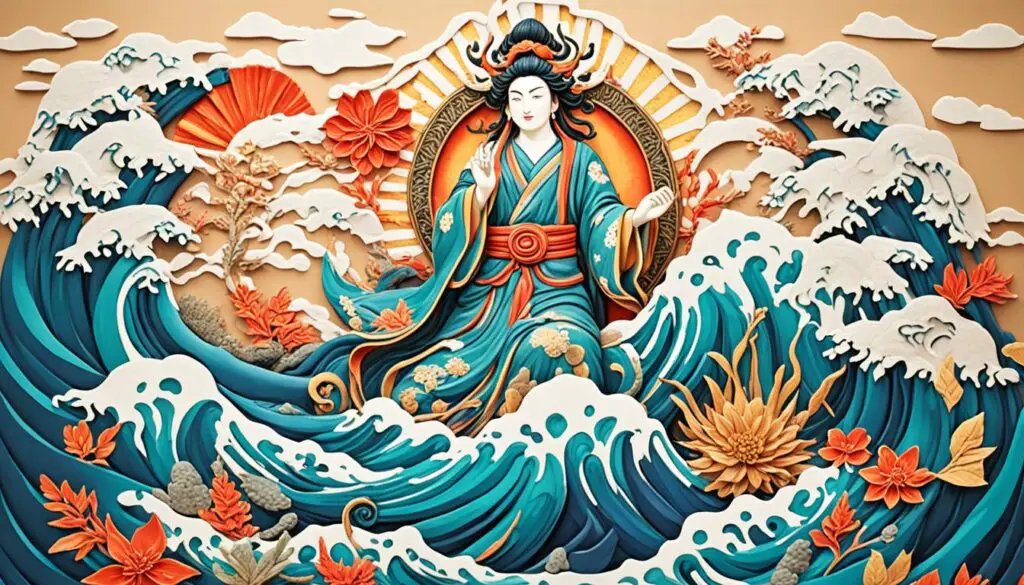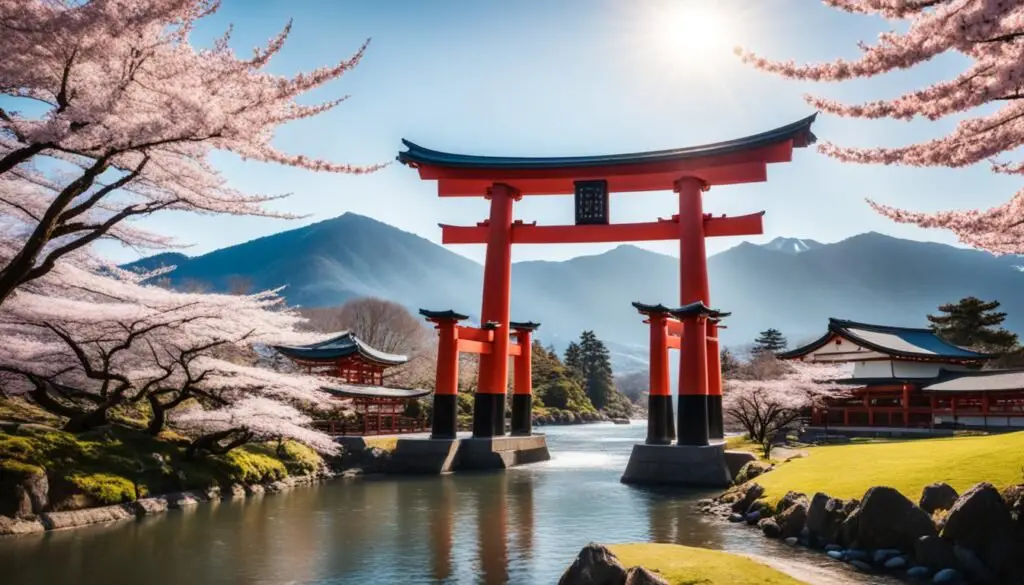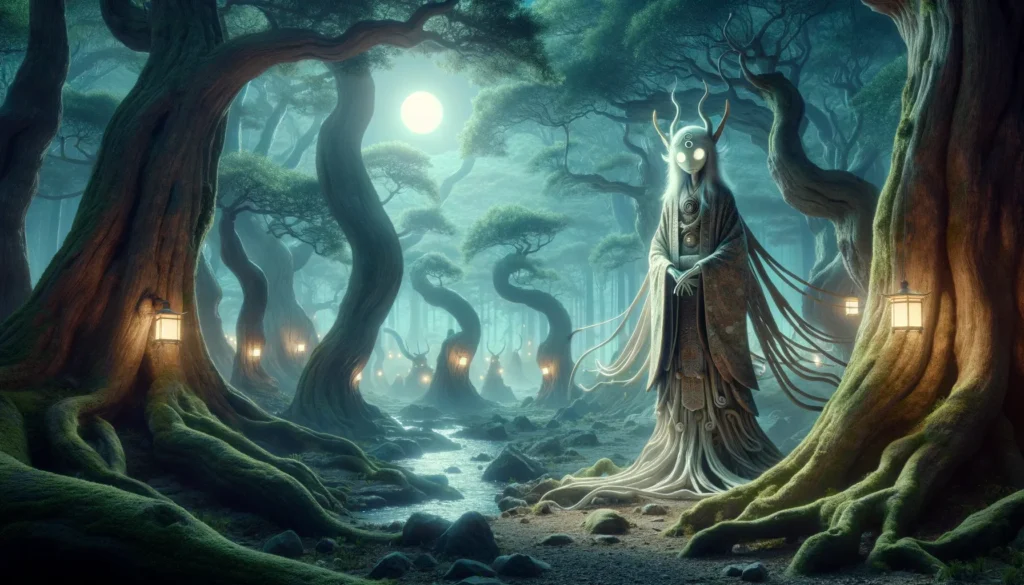In this article, we will delve into the captivating realm of Japanese mythology and explore the intriguing tale of how humans were created.
Japanese culture is steeped in ancient tales and rich folklore, and the creation myth holds a significant place within it.
By understanding the origins of humanity according to Japanese mythology, we can gain valuable insights into the cultural and societal aspects that shape Japanese society.
In Japanese mythology, humans were created by the deities Izanagi and Izanami, who first formed the islands of Japan and then wished to populate them. Through a divine ritual, they created deities and the first humans, signifying the divine origin of humanity and the close bond between the divine and natural worlds in Japanese culture.
Join us on this journey through the mythical world of Japanese folklore as we uncover the fascinating details of the creation myth and its influence on Japanese culture.
Key Takeaways:
- Japanese mythology offers a unique creation myth that explains the origins of humanity.
- The creation myth holds cultural and societal significance in Japanese culture.
- Ancient tales and folklore play a significant role in Japanese mythology and culture.
- The creation myth in Japanese mythology is influenced by Shinto beliefs and practices.
- Comparative analysis with other creation myths reveals both similarities and unique aspects of Japanese mythology.
- Japanese creation myths have had a lasting impact on Japanese art, literature, and religious practices.
The Pantheon of Japanese Mythology
The pantheon of Japanese mythology is a vast collection of deities and supernatural beings that play significant roles in the creation and development of the world.
These deities form the rich tapestry of Japanese mythology, with each having their own unique characteristics and stories.
In this section, we will focus on the key deities involved in the creation of humans. We will explore their roles, significance, and their place within the celestial and earthly realms.
Key Deities Involved in Creation
Within Japanese mythology, numerous deities take part in the creation of humanity. One such deity is Izanagi, the male counterpart to Izanami, who together laid the foundations for the earthly realm.
Izanagi is known as the deity of creation and is responsible for the birth of numerous gods and goddesses.
Another important deity is Amaterasu, the goddess of the sun, who is revered as the ancestor of the Japanese imperial family.
The Celestial and Earthly Realms
In Japanese mythology, there are two distinct realms: the celestial realm, also known as Takamagahara, and the earthly realm, known as Ashihara-no-Nakatsukuni.
The celestial realm is where the gods and goddesses reside, governing the heavens and overseeing the natural world.
The earthly realm, on the other hand, is inhabited by humans and serves as a bridge between the celestial and earthly realms.
This division between realms reinforces the hierarchical structure of the universe in Japanese mythology.
The Story of Creation in Japanese Mythology
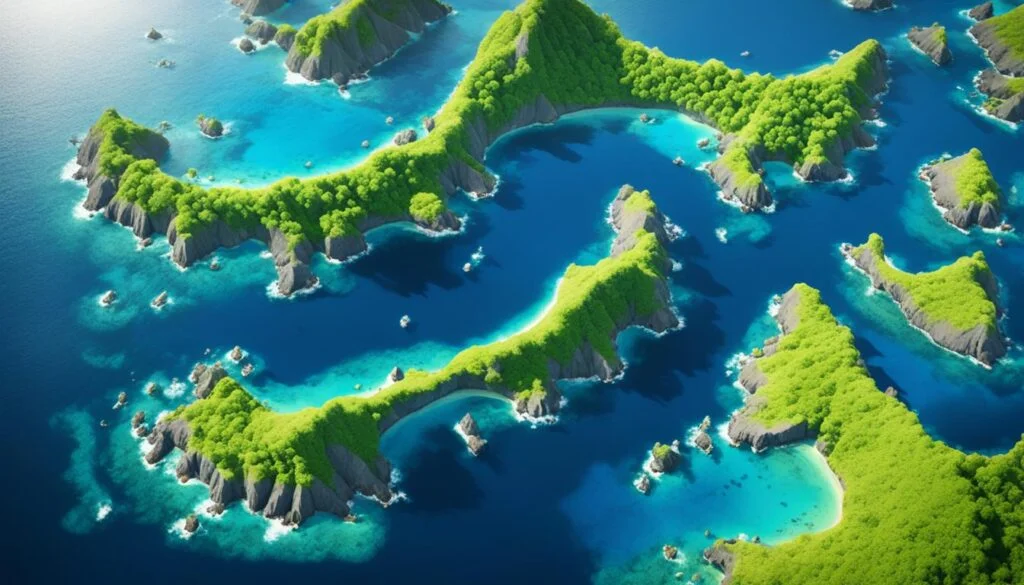
Japanese mythology offers a captivating creation story that explains the origins of the Japanese islands, as well as the birth of the gods and humanity. In this section, we will explore the fascinating details of these stories.
We will delve into the mythical events that led to the formation of the Japanese islands and the emergence of the gods and humanity.
The Creation of the Japanese Islands
In Japanese mythology, the creation of the Japanese islands is attributed to a deity named Izanagi and his consort, Izanami.
According to the myth, Izanagi and Izanami were tasked with creating the world. They stood on the “Heavenly Floating Bridge” and used a jeweled spear to stir the ocean’s depths.
When they lifted the spear out of the water, the drops that fell back into the ocean formed the Japanese islands.
These islands became the foundation for the subsequent events in Japanese mythology.
The Birth of the Gods and Humanity
Following the creation of the Japanese islands, Izanagi and Izanami gave birth to numerous gods and goddesses.
These divine beings played crucial roles in the ongoing development of the world. However, tragedy struck when Izanami died giving birth to the fire god, Kagutsuchi.
Distraught, Izanagi ventured to the underworld in an attempt to bring Izanami back. Although he failed, Izanagi purified himself in a river and gave birth to the sun goddess, Amaterasu, from his left eye.
From his nose came the moon god, Tsukuyomi, and from his right eye emerged the storm god, Susanoo.
These three deities went on to shape the world further and became central figures in Japanese mythology.
In addition to the deities, Izanagi also created humanity. As he bathed after his journey to the underworld, several gods were born from the impurities washed off his body.
These gods, known as the “Eight Great Deities of the Wako” or “Yashima Hachi-dai,” represented different aspects of human life and were believed to protect and guide humanity.
The creation of the Japanese islands and the birth of the gods and humanity form the foundation of Japanese mythology.
These ancient tales continue to shape the cultural and societal identity of Japan, reminding its people of their deep connection to the natural world and the divine forces that govern it.
Symbolism and Themes in the Creation Myth
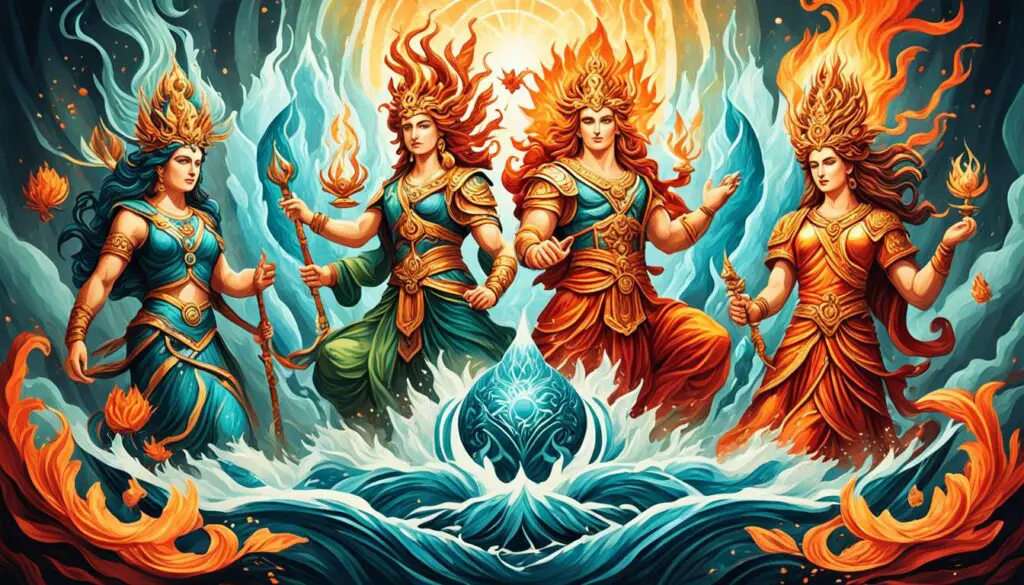
The creation myth in Japanese mythology is not just a story of how humans came into existence; it also contains rich symbolism and explores various themes.
By delving into the symbolism and themes present in the myth, we can gain a deeper understanding of its significance and the underlying ideas it conveys.
Purity and Pollution
One of the prominent themes in the creation myth is the concept of purity and pollution.
The myth often portrays the birth of humans and the world as a struggle between purity and pollution, with the forces of purity striving to maintain harmony and balance.
This symbolism reflects the belief in the importance of spiritual and physical purity in Japanese culture.
The creation myth emphasizes the need to protect and preserve purity, as it is seen as essential for the well-being of humanity and the world.
It highlights the consequences of pollution and the dangers it poses to life and existence.
Through this symbolism, the creation myth offers profound insights into the significance of purity and the impact of pollution on both individuals and society.
Life, Death, and Rebirth
Another significant theme explored in the creation myth is the cycle of life, death, and rebirth.
The myth portrays life as a continuous cycle, with death being a natural part of this cycle rather than an end.
It suggests that death is not the ultimate conclusion but rather a phase in the ongoing process of rebirth.
This theme reflects the belief in the cyclical nature of existence in Japanese culture. It conveys the idea that life is not a linear journey but rather a series of interconnected cycles, where death is merely a transition from one phase of existence to another.
By emphasizing the cyclical nature of life, the creation myth offers a perspective on the interconnectedness of all things and the continuous potential for renewal and transformation.
The symbolism and themes present in the creation myth of Japanese mythology provide profound insights into the cultural and philosophical ideas underlying Japanese culture.
They invite us to contemplate the concepts of purity and pollution, as well as the cyclical nature of life, death, and rebirth.
By exploring these concepts, we can deepen our understanding of the creation myth and its enduring relevance in Japanese society.
Influence of Shinto on the Creation Myth

Shinto, the indigenous religion of Japan, holds a significant influence on the creation myth.
To understand the connection between Shinto and the creation myth, we need to explore the core beliefs and practices of Shinto.
Shinto Beliefs and Practices
Shinto is deeply rooted in the belief that nature is divine and sacred. It emphasizes purity, harmony with the natural world, and the importance of rituals.
Shinto followers believe in the existence of Kami, which can be translated as “gods” or “spirits.”
These Kami can be found in various forms, such as natural elements like mountains, rivers, and trees, as well as ancestral spirits.
Shinto practices include purification rituals, prayers, and offerings to the Kami. These rituals are performed to maintain harmony and balance between humans, nature, and the spiritual realm.
Shinto followers visit shrines, participate in ceremonies, and engage in personal acts of devotion to express their reverence for the Kami and seek blessings.
The Kami and Ancestral Worship
The concept of Kami is central to Shinto beliefs and plays a significant role in the creation myth.
Kami are considered divine beings, both powerful and benevolent, and they are believed to have a close connection to humanity.
In the creation myth, Kami are depicted as active participants in the formation of the world and the birth of humanity.
They are responsible for shaping the natural environment and providing guidance and protection to humans.
Alongside the worship of Kami, ancestral worship is another essential aspect of Shinto. Ancestral spirits are venerated as part of the extended family and community.
Ancestor rituals, known as “kōrei-shiki,” involve offering prayers, food, and other items to honor and remember the departed ancestors.
This practice of ancestral worship connects the living with their ancestral lineage and reinforces the importance of family and community bonds within Shinto practices.
In the next section, we will compare the creation myth in Japanese mythology with creation myths from other cultural and religious traditions to identify both similarities and unique aspects.
Comparative Analysis with Other Creation Myths
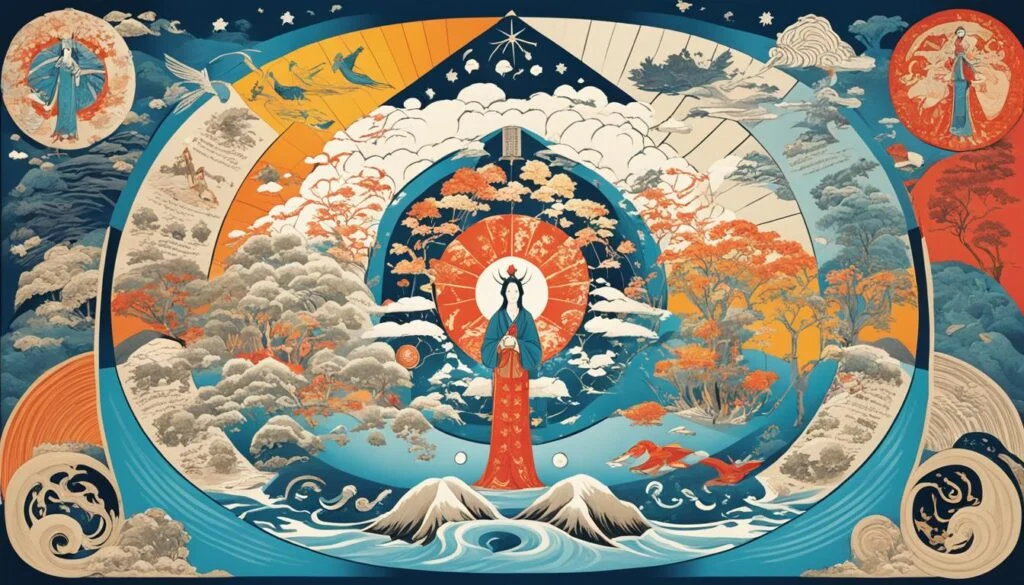
Japanese mythology is rich and diverse, offering a creation myth that shares similarities with creation myths from various other cultural and religious traditions.
In this section, we will conduct a comparative analysis, exploring the similarities between the Japanese creation myth and those of other traditions.
By examining these shared elements, we can gain a deeper understanding of the universal themes and concepts that exist across different cultures.
Similarities with Other Traditions
When comparing creation myths from different traditions, it becomes evident that certain themes and motifs recur.
For example, the concept of a divine entity or entities responsible for the creation of the world and humanity is prevalent in multiple cultures.
These deities often possess unique abilities or characteristics and play a significant role in shaping the course of existence.
Additionally, many creation myths portray a separation or division between the celestial and earthly realms.
This dichotomy represents the distinction between the divine and mortal realms and often serves as a narrative device to explain the origins of humanity and their relationship with the gods.
In examining the similarities between the Japanese creation myth and other traditions, we gain a broader perspective on the fundamental questions that human societies have sought to answer throughout history.
Unique Aspects of Japanese Mythology
While there are striking similarities between the Japanese creation myth and other traditions, Japanese mythology also possesses unique aspects that set it apart.
One key characteristic is the emphasis on the natural world and its interconnectedness with humanity.
Japanese mythology often portrays a close relationship between humans and nature, highlighting the reverence and respect given to the natural environment.
This emphasis on harmony and balance between humans and the natural world reflects the deep-rooted connection between Japanese culture and its natural surroundings.
Furthermore, Japanese mythology incorporates elements of ancestor worship, where deceased ancestors are revered as protective spirits known as “kami.”
This belief in the presence of ancestral spirits adds a distinctive dimension to the Japanese creation myth, emphasizing the importance of lineage and the continuation of traditions across generations.
These unique aspects of Japanese mythology contribute to its distinctiveness and highlight the cultural significance it holds within Japanese society.
The Cultural Legacy of Japanese Creation Myths
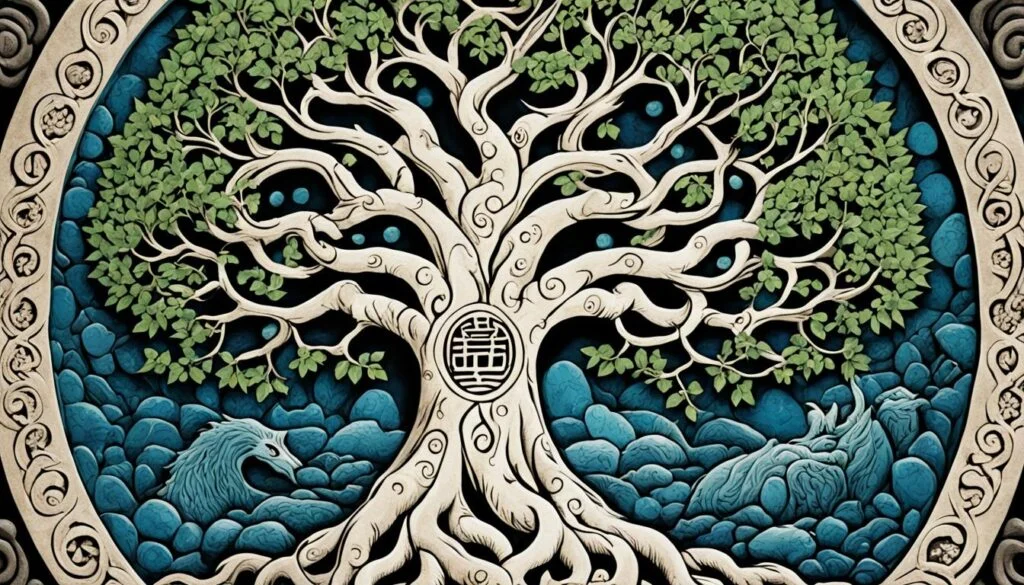
Japanese creation myths have left an indelible mark on Japanese culture and society, shaping various aspects of their art, literature, and religious practices.
These myths hold a significant cultural legacy that continues to influence and inspire the Japanese people.
Influence on Japanese Culture and Society
The impact of Japanese creation myths on the country’s culture cannot be overstated. Artistic expressions such as traditional paintings, sculptures, and calligraphy often draw inspiration from these ancient tales.
They provide a foundation for artistic techniques and themes, reflecting the reverence for nature and the divine found in Japanese culture.
Literature, too, has been deeply influenced by these myths. Many classic works of Japanese literature, including renowned novels and poetic collections, incorporate elements of the creation myths.
These stories offer literary motifs, symbolism, and moral lessons that continue to resonate with readers.
Religiously, the creation myths have played a crucial role in shaping Japan’s indigenous religion, Shinto.
Shinto beliefs and rituals reflect the reverence for the natural world and the inextricable link between the divine and human existence.
The creation stories provide a foundation for Shinto practices, including ancestral worship and the veneration of nature spirits known as Kami.
Modern Interpretations and Relevance
Despite their ancient origins, Japanese creation myths maintain their relevance in modern Japanese society.
They continue to inspire artists, writers, and filmmakers, who reinterpret these myths in contemporary contexts.
The themes and symbols woven into the creation stories resonate with the universal human experience, allowing for fresh interpretations that reflect the cultural and societal changes of the times.
Moreover, Japanese creation myths serve as a source of national identity and pride. They reinforce the unique cultural heritage of Japan and foster a sense of unity and belonging among its people.
The preservation and continued exploration of these myths contribute to the rich tapestry of Japanese culture and enable future generations to connect with their cultural roots.
Conclusion
In conclusion, Japanese mythology presents a captivating creation myth that delves into the origins of humanity in a truly unique and intricate way.
Through our exploration of this myth, we have gained valuable insights into the cultural and societal significance it holds in Japanese culture.
The creation myth not only explains the origin of human beings but also provides a deeper understanding of the Japanese people’s relationship with the natural world and their reverence for the divine.
The depth and richness of Japanese mythology are evident in the creation myth. The stories and symbolism within the myth reflect important themes such as purity, pollution, life, death, and rebirth.
These themes resonate with the cyclical nature of existence and offer a profound perspective on the human experience.
Furthermore, the influence of Shinto, the indigenous religion of Japan, is deeply ingrained in the creation myth.
The belief in Kami, the divine beings, and the practice of ancestral worship are intertwined with the mythological narrative, highlighting the close connection between spirituality and the natural world in Japanese culture.
Frequently Asked Questions
Q: Who is the Japanese god that created humans?
A: Izanagi and Izanami are the divine couple in Japanese mythology credited with creating the first islands of Japan and subsequently humans, along with many deities of the Japanese pantheon.
Q: How did Izanagi and Izanami create the world?
A: Izanagi and Izanami created the world by using a heavenly jeweled spear to stir the primordial ocean. Droplets that fell from the spear when they lifted it formed the islands of Japan. They then created numerous deities and natural features of the earth through their union.
Q: What is the founding myth of Japan?
A: The founding myth of Japan involves the divine beings Izanagi and Izanami, who created the Japanese archipelago by stirring the ocean with a celestial spear. Their actions and descendants, especially their grandson, the sun goddess Amaterasu’s descendant, Emperor Jimmu, are central to Japan’s creation story and imperial lineage.
Q: How was Izanagi created?
A: Izanagi, along with Izanami, were created by the primeval gods, or kami, who existed at the beginning of the universe in Japanese mythology. They were tasked with completing the creation of the world and producing other deities.
Q: Why is Izanagi forbidden?
A: The term “forbidden” in the context of Izanagi often refers to the restrictions and taboos associated with the purification rituals he performed after visiting the underworld to retrieve Izanami. This includes the prohibition against looking at his dead wife, which he broke, leading to the permanent separation of life and death.


